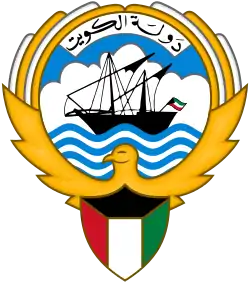Iran–Kuwait relations
Kuwait and Iran have longstanding historical ties spanning hundreds of years, particularly in the pre-oil era. Kuwait describes its relations with Iran as "excellent and historical".[3][4]
 | |
Iran |
Kuwait |
|---|---|
| Diplomatic mission | |
| Embassy of Kuwait, Tehran | Embassy of Iran, Kuwait |
| Envoy | |
| Ambassador Dr. Ali Reza Enayati[1] | Ambassador Majdi adh-Dhafiri[2] |
20th century
Historically, Kuwait had close political, economic, and cultural ties to Iran. However in the 1980s, Kuwait sided with Iraq during the Iran-Iraq War.[5] As for the result, Iranian–Kuwaiti relations were damaged and Iran had placed Kuwaiti ships, including tankers, under attack.[6] Kuwait's relations with Iran later improved when Iran denounced Iraq for invading Kuwait in the Gulf War at 1991.[7]
Recent history
Kuwait's plans for regional development, including the "Silk City project" that aims to develop the Kuwaiti Islands, includes developing mutually beneficial economic ties with Iran.[5]
In 2017, Kuwait ordered the expulsion of the Iranian ambassador after 23 Kuwaiti citizens of Iranian origin were convicted of allegedly spying for the Lebanese group Hezbollah.[8]
Despite these concerns, Kuwait's relations with Iran are friendly and Kuwait declined to follow Saudi Arabia's lead in severing diplomatic relations following the 2016 attack on the Saudi diplomatic missions in Iran.[5]
After U.S. President Donald Trump announced the United States withdrawal from the Iran nuclear deal, Kuwait opted to maintain formal ties with Iran[9] while Saudi Arabia, Bahrain, and the Uinted Arab Emirates voiced strong support for the withdrawal.[5]
Kuwaitis of Iranian origin
'Ajam of Kuwait (Persians of Kuwait)[10][11] are Kuwaiti citizens of Iranian origin, who migrated to Kuwait over the last couple of hundred years.[12][13] Historically, Persian ports provided most of Kuwait's economic needs.[14] Marafi Behbahani was one of the first merchants to settle in Kuwait in the 18th century.[15]
The majority of Shia Kuwaiti citizens are of Iranian ancestry.[16][17][18][19][20][21][22] However, some Kuwaitis of Iranian origin are Sunni. The Kuwaitis of Iranian Balochi origin are predominantly Sunni Muslim.[23] Balochi families first immigrated to Kuwait in the 19th century.[24]
The Persian sub-dialects of Larestani, Khonji, Bastaki and Gerashi have influenced the vocabulary of Kuwaiti Arabic.[25]
Further reading
References
- "Archived copy". Archived from the original on 2015-01-20. Retrieved 2015-01-20.CS1 maint: archived copy as title (link)
- http://www.kuna.net.kw/ArticleDetails.aspx?id=2411024&Language=en
- "Kuwait's relations with Iran 'excellent, historic' Relations didn't weaken after the KSA-Iranian diplomatic ties were cut on January 2nd 2016". Kuwait News Agency.
- "Kuwait says relations with Iran are 'excellent'". The National.
- Albloshi, Hamad H. (2018-05-24). "Kuwait's careful balancing act with Iran, Saudi Arabia". Al-Monitor. Retrieved 2018-07-28.
- https://scholarship.law.duke.edu/cgi/viewcontent.cgi?article=3026&context=dlj
- https://www.researchgate.net/publication/50211251_Iraqi_Invasion_of_Kuwait_as_Turning_Point_in_Iran-Saudi_Relationship
- "Iran says ambassador to remain in Kuwait despite row". Reuters. 2017-07-24. Retrieved 2018-07-28.
- http://www.washingtontimes.com, The Washington Times. "Kuwait continues Iran straddle after Trump decision". The Washington Times. Retrieved 2018-07-28.
- Article in AL-AAN online newspaper Archived 15 April 2015 at the Wayback Machine (in Arabic) November 2010
- Article by Waleed aj-Jasim in Al-Watan daily newspaper Archived 15 April 2015 at the Wayback Machine (in Arabic). 25 May 2013
- "Policing Iranian Sanctions: Trade, Identity, and Smuggling Networks in the Arabian Gulf" (PDF). pp. 25–27. Archived (PDF) from the original on 20 December 2016.
- Taqi, Hanan (2010). Two ethnicities, three generations: Phonological variation and change in Kuwait (PDF) (PhD). Newcastle University. Archived from the original (PDF) on 19 October 2013. Retrieved 5 December 2016.
- Peterson, John (2016). The Emergence of the Gulf States: Studies in Modern History. J. E. Peterson. p. 107. ISBN 9781472587626. Archived from the original on 5 January 2014.
- "The Shia Migration from Southwestern Iran to Kuwait: Push-Pull Factors during the Late Nineteenth and Early Twentieth Centuries". Georgia State University. 2014. Archived from the original on 27 December 2016.
- Butenschon, Nils A.; Davis, Uri; Hassassian, Manuel (2000). Citizenship and the State in the Middle East: Approaches and Applications. Nils August Butenschøn, Uri Davis, Manuel Sarkis Hassassian. p. 190. ISBN 9780815628293.
- Binder, Leonard (1999). Ethnic Conflict and International Politics in the Middle East (PDF). p. 164. ISBN 9780813016870. Archived from the original on 8 December 2013.
Unlike the Shi'a of Saudi Arabia or Bahrain, the Kuwaiti Shi'a mostly are of Persian descent.
- Hertog, Steffen; Luciani, Giacomo; Valeri, Marc (2013). Business Politics in the Middle East. Rivka Azoulay. p. 71. ISBN 9781849042352.
- Ende, Werner; Steinbach, Udo (2002). Islam in the World Today: A Handbook of Politics, Religion, Culture, and Society. Werner Ende, Udo Steinbach. p. 533. ISBN 0801464897.
- Potter, Lawrence G. (June 2014). Sectarian Politics in the Persian Gulf. Lawrence G. Potter. p. 135. ISBN 9780190237967.
- Louër, Laurence (2011). Transnational Shia Politics: Religious and Political Networks in the Gulf. Laurence Louër. p. 47. ISBN 9781849042147.
- Dénes Gazsi. "The Persian Dialects of the Ajam in Kuwait" (PDF). The University of Iowa.
- "The Baluch Presence in the Persian Gulf" (PDF). 2013. pp. 742–743. Archived (PDF) from the original on 24 April 2014.
- The Shia Migration from Southwestern Iran to Kuwait: Push-Pull Factors during the Late Nineteenth and Early Twentieth Centuries. Georgia State University. 2012. pp. 71–72. Archived from the original on 5 January 2014.
- Al-Tajir (2013). Lang & Linguistic in Bahrain Mon. Al-Tajir. p. 11. ISBN 9781136136269.

